The Effects of Online Cognitive Behavioral Therapy on Postpartum Depression: A Systematic Review and Meta-Analysis
Abstract
1. Introduction
2. Materials and Methods
2.1. Search Strategy
2.2. Eligibility Criteria
2.2.1. Participants
2.2.2. Intervention
2.2.3. Comparison
2.2.4. Outcome
2.2.5. Study Design
2.3. Study Selection
2.4. Quality Assessment
2.5. Data Extraction
2.6. Data Analyses
2.7. Certainty Assessment of the Body of Evidence
3. Results
3.1. Search Results and Study Selection
3.2. Study Characteristics
3.3. Risk of Bias Assessment
3.4. Effects of Online Cognitive Behavioral Therapy on Postpartum Depression Outcomes
3.4.1. Overall Postpartum Depressive Symptoms
3.4.2. Subgroup Analysis of Postpartum Depressive Symptoms
Culture
Intervention Duration
Intervention Number
Each Intervention Duration
Intervention Module Number
Intervention Platform
Intervention Form
Professional Guidance
3.5. Sensitivity Analysis and Assessment of Publication Bias
3.6. Certainty of the Body of Evidence
4. Discussion
4.1. Interpretation of Findings
4.2. Limitations
4.3. Relevance for Clinical Practice
5. Conclusions
Supplementary Materials
Author Contributions
Funding
Institutional Review Board Statement
Informed Consent Statement
Data Availability Statement
Acknowledgments
Conflicts of Interest
References
- Mughal, S.; Azhar, Y.; Siddiqui, W. Postpartum Depression; StatPearls Publishing: Treasure Island, FL, USA, 2023. [Google Scholar]
- Wang, Z.; Liu, J.; Shuai, H.; Cai, Z.; Fu, X.; Liu, Y.; Xiao, X.; Zhang, W.; Krabbendam, E.; Liu, S.; et al. Mapping global prevalence of depression among postpartum women. Transl. Psychiatry 2021, 11, 543. [Google Scholar] [CrossRef] [PubMed]
- Liu, X.; Wang, S.; Wang, G. Prevalence and Risk Factors of Postpartum Depression in Women: A Systematic Review and Meta-analysis. J. Clin. Nurs. 2022, 31, 2665–2677. [Google Scholar] [CrossRef] [PubMed]
- Nisar, A.; Yin, J.; Waqas, A.; Bai, X.; Wang, D.; Rahman, A.; Li, X. Prevalence of perinatal depression and its determinants in Mainland China: A systematic review and meta-analysis. J. Affect. Disord. 2020, 277, 1022–1037. [Google Scholar] [CrossRef] [PubMed]
- Saharoy, R.; Potdukhe, A.; Wanjari, M.; Taksande, A.B. Postpartum Depression and Maternal Care: Exploring the Complex Effects on Mothers and Infants. Cureus 2023, 15, e41381. [Google Scholar] [CrossRef]
- Dowse, E.; Chan, S.; Ebert, L.; Wynne, O.; Thomas, S.; Jones, D.; Fealy, S.; Evans, T.-J. Impact of Perinatal Depression and Anxiety on Birth Outcomes: A Retrospective Data Analysis. Matern. Child Health J. 2020, 24, 718–726. [Google Scholar] [CrossRef]
- Higgins, N.E.; Rose, M.J.; Gardner, T.J.; Crawford, J.N. Perinatal Depression Treatment Guidelines for Obstetric Providers. Obstet. Gynecol. Clin. N. Am. 2023, 50, 589–607. [Google Scholar] [CrossRef]
- Beck, A.; Rush, A.; Shaw, B.; Emery, G. The Cognitive Therapy of Depression; Guilford Press: New York, NY, USA, 1979; Volume 36. [Google Scholar]
- Dryden, W. Handbook of Cognitive-Behavioral Therapies, 3rd ed.; Freeman, A., Felgoise, S.H., Nezu, C.M., Nezu, A.M., Reinecke, M.A., Eds.; Guilford Press: New York, NY, USA, 2010. [Google Scholar] [CrossRef]
- Dobson, D.J.G.; Dobson, K.S. Evidence-Based Practice of Cognitive-Behavioral Therapy; Guilford Press: New York, NY, USA, 2009. [Google Scholar]
- National Institute for Health and Care Excellence. Antenatal and Postnatal Mental Health—Clinical Management and Service Guidance (Updated ed.); National Institute for Health and Care Excellence: London, UK, 2018. [Google Scholar]
- Gelenberg, A.J.; Freeman, M.P.; Markowitz, J.C.; Rosenbaum, J.F.; Thase, M.E.; Trivedi, M.H. Practice Guideline for the Treatment of Patients with Major Depressive Disorder; American Psychiatric Association: Washington, DC, USA, 2010. [Google Scholar]
- British Thoracic Society. Scottish Intercollegiate Guidelines Network A National Clinical Guideline: Perinatal Mental Health Conditions; British Thoracic Society: London, UK, 2023. [Google Scholar]
- Amani, B.; Merza, D.; Savoy, C.; Streiner, D.; Bieling, P.; Ferro, M.A.; Van Lieshout, R.J. Peer-Delivered Cognitive-Behavioral Therapy for Postpartum Depression: A Randomized Controlled Trial. J. Clin. Psychiatry 2021, 83, 21m13928. [Google Scholar] [CrossRef]
- Ammerman, R.T.; Putnam, F.W.; Altaye, M.; Stevens, J.; Teeters, A.R.; Van Ginkel, J.B. A clinical trial of in-home CBT for depressed mothers in home visitation. Behav. Ther. 2013, 44, 359–372. [Google Scholar] [CrossRef]
- Milgrom, J.; Holt, C.J.; Gemmill, A.W.; Ericksen, J.; Leigh, B.; Buist, A.; Schembri, C. Treating postnatal depressive symptoms in primary care: A randomised controlled trial of GP management, with and without adjunctive counselling. BMC Psychiatry 2011, 11, 95. [Google Scholar] [CrossRef]
- Huh, K.; Layton, H.; Savoy, C.D.; Ferro, M.A.; Bieling, P.J.; Hicks, A.; Van Lieshout, R.J. Online Public Health Nurse–Delivered Group Cognitive Behavioral Therapy for Postpartum Depression: A Randomized Controlled Trial During the COVID-19 Pandemic. J. Clin. Psychiatry 2023, 84, 48096. [Google Scholar] [CrossRef]
- Ngai, F.-W.; Wong, P.W.-C.; Leung, K.-Y.; Chau, P.-H.; Chung, K.-F. The Effect of Telephone-Based Cognitive-Behavioral Therapy on Postnatal Depression: A Randomized Controlled Trial. Psychother. Psychosom. 2015, 84, 294–303. [Google Scholar] [CrossRef] [PubMed]
- Denecke, K.; Schmid, N.; Nüssli, S. Implementation of Cognitive Behavioral Therapy in e-Mental Health Apps: Literature Review. J. Med. Internet Res. 2022, 24, e27791. [Google Scholar] [CrossRef] [PubMed]
- Sheeber, L.B.; Seeley, J.R.; Feil, E.G.; Davis, B.; Sorensen, E.; Kosty, D.B.; Lewinsohn, P.M. Development and pilot evaluation of an Internet-facilitated cognitive-behavioral intervention for maternal depression. J. Consult. Clin. Psychol. 2012, 80, 739–749. [Google Scholar] [CrossRef] [PubMed]
- Milgrom, J.; Danaher, B.G.; Seeley, J.R.; Holt, C.J.; Holt, C.; Ericksen, J.; Tyler, M.S.; Gau, J.M.; Gemmill, A.W. Internet and Face-to-face Cognitive Behavioral Therapy for Postnatal Depression Compared with Treatment as Usual: Randomized Controlled Trial of MumMoodBooster. J. Med. Internet Res. 2021, 23, e17185. [Google Scholar] [CrossRef]
- Seo, J.-M.; Kim, S.-J.; Na, H.; Kim, J.-H.; Lee, H. Effectiveness of a Mobile Application for Postpartum Depression Self-Management: Evidence from a Randomised Controlled Trial in South Korea. Healthcare 2022, 10, 2185. [Google Scholar] [CrossRef]
- Roman, M.; Constantin, T.; Bostan, C.M. The efficiency of online cognitive-behavioral therapy for postpartum depressive symptomatology: A systematic review and meta-analysis. Women Health 2020, 60, 99–112. [Google Scholar] [CrossRef]
- Babiy, Z.; Layton, H.; Savoy, C.D.; Xie, F.; Brown, J.S.L.; Bieling, P.J.; Streiner, D.L.; Ferro, M.A.; Van Lieshout, R.J. One-Day Peer-Delivered Cognitive Behavioral Therapy-Based Workshops for Postpartum Depression: A Randomized Controlled Trial. Psychother. Psychosom. 2024, 93, 129–140. [Google Scholar] [CrossRef]
- Carona, C.; Pereira, M.; Araújo-Pedrosa, A.; Canavarro, M.C.; Fonseca, A. The Efficacy of Be a Mom, a Web-Based Intervention to Prevent Postpartum Depression: Examining Mechanisms of Change in a Randomized Controlled Trial. JMIR Ment. Health 2023, 10, e39253. [Google Scholar] [CrossRef]
- Carona, C.; Pereira, M.; Araújo-Pedrosa, A.; Monteiro, F.; Cristina Canavarro, M.; Fonseca, A. For Whom and for How Long Does the “Be a Mom” Intervention Work? A Secondary Analysis of Data from a Randomized Controlled Trial Exploring the Mid-Term Efficacy and Moderators of Treatment Response. Behav. Ther. 2023, 55, 768–785. [Google Scholar] [CrossRef]
- Fonseca, A.; Alves, S.; Monteiro, F.; Gorayeb, R.; Canavarro, M.C. Be a mom, a Web-Based Intervention to Prevent Postpartum Depression: Results From a Pilot Randomized Controlled Trial. Behav. Ther. 2020, 51, 616–633. [Google Scholar] [CrossRef]
- Jannati, N.; Mazhari, S.; Ahmadian, L.; Mirzaee, M. Effectiveness of an app-based cognitive behavioral therapy program for postpartum depression in primary care: A randomized controlled trial. Int. J. Med. Inf. 2020, 141, 104145. [Google Scholar] [CrossRef]
- Merza, D.; Amani, B.; Savoy, C.; Babiy, Z.; Bieling, P.J.; Streiner, D.L.; Ferro, M.A.; Van Lieshout, R.J. Online peer-delivered group cognitive-behavioral therapy for postpartum depression: A randomized controlled trial. Acta Psychiatr. Scand. 2023, 150, 422–432. [Google Scholar] [CrossRef] [PubMed]
- Shariatpanahi, G.; Effatpanah, M.; Moienafshar, A.; Shariati, M.; Kheiltash, A.; Ahadpourkhanghah, E.; Khaneghah, A.A. Comparing the Effectiveness of Internet-Based Cognitive Behavioral Therapy and Drug Therapy for Treating Postpartum Depression and Children Weight Gain: A Randomized Clinical Trial. Int. J. High Risk Behav. Addict. 2023, 11, e117830. [Google Scholar] [CrossRef]
- Van Lieshout, R.J.; Layton, H.; Savoy, C.D.; Brown, J.S.L.; Ferro, M.A.; Streiner, D.L.; Bieling, P.J.; Feller, A.; Hanna, S. Effect of Online 1-Day Cognitive Behavioral Therapy–Based Workshops Plus Usual Care vs Usual Care Alone for Postpartum Depression: A Randomized Clinical Trial. JAMA Psychiatry 2021, 78, 1200. [Google Scholar] [CrossRef]
- Higgins, J.; Thomas, J.; Chandler, J.; Cumpston, M.; Li, T.; Page, M. Cochrane Handbook for Systematic Reviews of Interventions Version 6.3 (Updated February 2022). Available online: https://training.cochrane.org/handbook/current (accessed on 15 June 2024).
- Page, M.J.; McKenzie, J.E.; Bossuyt, P.M.; Boutron, I.; Hoffmann, T.C.; Mulrow, C.D.; Shamseer, L.; Tetzlaff, J.M.; Akl, E.A.; Brennan, S.E.; et al. The PRISMA 2020 statement: An updated guideline for reporting systematic reviews. BMJ 2021, 372, n71. [Google Scholar] [CrossRef]
- Loughnan, S.A.; Butler, C.; Sie, A.A.; Grierson, A.B.; Chen, A.Z.; Hobbs, M.J.; Joubert, A.E.; Haskelberg, H.; Mahoney, A.; Holt, C.; et al. A randomised controlled trial of ‘MUMentum postnatal’: Internet-delivered cognitive behavioural therapy for anxiety and depression in postpartum women. Behav. Res. Ther. 2019, 116, 94–103. [Google Scholar] [CrossRef]
- Milgrom, J.; Danaher, B.G.; Gemmill, A.W.; Holt, C.; Holt, C.J.; Seeley, J.R.; Tyler, M.S.; Ross, J.; Ericksen, J. Internet Cognitive Behavioral Therapy for Women With Postnatal Depression: A Randomized Controlled Trial of MumMoodBooster. J. Med. Internet Res. 2016, 18, e54. [Google Scholar] [CrossRef]
- O’Mahen, H.A.; Woodford, J.; McGinley, J.; Warren, F.C.; A Richards, D.; Lynch, T.R.; Taylor, R.S. Internet-based behavioral activation—Treatment for postnatal depression (Netmums): A randomized controlled trial. J. Affect. Disord. 2013, 150, 814–822. [Google Scholar] [CrossRef]
- O’Mahen, H.A.; Richards, D.A.; Woodford, J.; Wilkinson, E.; McGinley, J.; Taylor, R.S.; Warren, F.C. Netmums: A phase II randomized controlled trial of a guided Internet behavioural activation treatment for postpartum depression. Psychol. Med. 2014, 44, 1675–1689. [Google Scholar] [CrossRef]
- Pugh, N.E.; Hadjistavropoulos, H.D.; Dirkse, D. A Randomised Controlled Trial of Therapist-Assisted, Internet-Delivered Cognitive Behavior Therapy for Women with Maternal Depression. PLoS ONE 2016, 11, e0149186. [Google Scholar] [CrossRef]
- Wozney, L.; Olthuis, J.; Lingley-Pottie, P.; McGrath, P.J.; Chaplin, W.; Elgar, F.; Cheney, B.; Huguet, A.; Turner, K.; Kennedy, J. Strongest FamiliesTM Managing Our Mood (MOM): A randomized controlled trial of a distance intervention for women with postpartum depression. Arch. Womens Ment. Health 2017, 20, 525–537. [Google Scholar] [CrossRef] [PubMed]
- Buss, J.F.; Steinberg, J.S.; Banks, G.; Horani, D.; Rutter, L.A.; Wasil, A.R.; Ramirez, I.; Lorenzo-Luaces, L. Availability of Internet-Based Cognitive-Behavioral Therapies for Depression: A Systematic Review. Behav. Ther. 2024, 55, 201–211. [Google Scholar] [CrossRef] [PubMed]
- Wilhelm, S.; Weingarden, H.; Ladis, I.; Braddick, V.; Shin, J.; Jacobson, N.C. Cognitive-Behavioral Therapy in the Digital Age: Presidential Address. Behav. Ther. 2020, 51, 1–14. [Google Scholar] [CrossRef] [PubMed]
- Pettman, D.; O’Mahen, H.; Blomberg, O.; Svanberg, A.S.; Von Essen, L.; Woodford, J. Effectiveness of cognitive behavioural therapy-based interventions for maternal perinatal depression: A systematic review and meta-analysis. BMC Psychiatry 2023, 23, 208. [Google Scholar] [CrossRef]
- Udd-Granat, L.; Lahti, J.; Donnelly, M.; Treanor, C.; Pirkola, S.P.; Lallukka, T.; Kouvonen, A. Internet-delivered cognitive behavioral therapy (iCBT) for common mental disorders and subsequent sickness absence: A systematic review and meta-analysis. Scand. J. Public Health 2023, 51, 137–147. [Google Scholar] [CrossRef]
- Qiao, J.; Wang, Y.; Li, X.; Jiang, F.; Zhang, Y.; Ma, J.; Song, Y.; Ma, J.; Fu, W.; Pang, R.; et al. A Lancet Commission on 70 years of women’s reproductive, maternal, newborn, child, and adolescent health in China. Lancet 2021, 397, 2497–2536. [Google Scholar] [CrossRef]
- The Lancet Perinatal depression: A neglected aspect of maternal health. Lancet 2023, 402, 667. [CrossRef]
- Bai, X.; Song, Z.; Zhou, Y.; Wang, X.; Wang, Y.; Zhang, D. Bibliometrics and Visual Analysis of the Research Status and Trends of Postpartum Depression From 2000 to 2020. Front. Psychol. 2021, 12, 665181. [Google Scholar] [CrossRef]
- Dosani, A.; Arora, H.; Mazmudar, S. mHealth and Perinatal Depression in Low-and Middle-Income Countries: A Scoping Review of the Literature. Int. J. Environ. Res. Public Health 2020, 17, 7679. [Google Scholar] [CrossRef]
- Raaj, S.; Verghese, V.; Tharmaseelan, M.; Duffy, R.; Sinnadorai, N.K.S.T.N.K. Perinatal mental health in Malaysia: Understanding the treatment gap and recommendations for the future. BJPsych Int. 2023, 20, 9–12. [Google Scholar] [CrossRef]
- National Institute for Health and Care Excellence. Depression in Adults: Treatment and Management. Available online: https://www.nice.org.uk/guidance/ng222 (accessed on 17 March 2025).
- Cuijpers, P.; Franco, P.; Ciharova, M.; Miguel, C.; Segre, L.; Quero, S.; Karyotaki, E. Psychological treatment of perinatal depression: A meta-analysis. Psychol. Med. 2023, 53, 2596–2608. [Google Scholar] [CrossRef] [PubMed]
- Dear, B.F.; Titov, N.; Schwencke, G.; Andrews, G.; Johnston, L.; Craske, M.G.; McEvoy, P. An open trial of a brief transdiagnostic internet treatment for anxiety and depression. Behav. Res. Ther. 2011, 49, 830–837. [Google Scholar] [CrossRef] [PubMed]
- Lau, Y.; Htun, T.P.; Wong, S.N.; Tam, W.S.W.; Klainin-Yobas, P. Therapist-Supported Internet-Based Cognitive Behavior Therapy for Stress, Anxiety, and Depressive Symptoms Among Postpartum Women: A Systematic Review and Meta-Analysis. J. Med. Internet Res. 2017, 19, e138. [Google Scholar] [CrossRef]
- Morgan, C.; Mason, E.; Newby, J.M.; Mahoney, A.E.; Hobbs, M.J.; McAloon, J.; Andrews, G. The effectiveness of unguided internet cognitive behavioural therapy for mixed anxiety and depression. Internet Interv. 2017, 10, 47–53. [Google Scholar] [CrossRef]
- Dear, B.F.; Fogliati, V.J.; Fogliati, R.; Johnson, B.; Boyle, O.; Karin, E.; Gandy, M.; Kayrouz, R.; Staples, L.G.; Titov, N. Treating anxiety and depression in young adults: A randomised controlled trial comparing clinician-guided versus self-guided Internet-delivered cognitive behavioural therapy. Aust. N. Z. J. Psychiatry 2018, 52, 668–679. [Google Scholar] [CrossRef]
- Laurant, M.; van der Biezen, M.; Wijers, N.; Watananirun, K.; Kontopantelis, E.; van Vught, A.J. Nurses as substitutes for doctors in primary care. Cochrane Database Syst. Rev. 2018, 7, CD001271. [Google Scholar] [CrossRef]
- Hong, S.; Lee, S.; Song, K.; Kim, M.; Kim, Y.; Kim, H.; Kim, H. A nurse-led mHealth intervention to alleviate depressive symptoms in older adults living alone in the community: A quasi-experimental study. Int. J. Nurs. Stud. 2023, 138, 104431. [Google Scholar] [CrossRef]

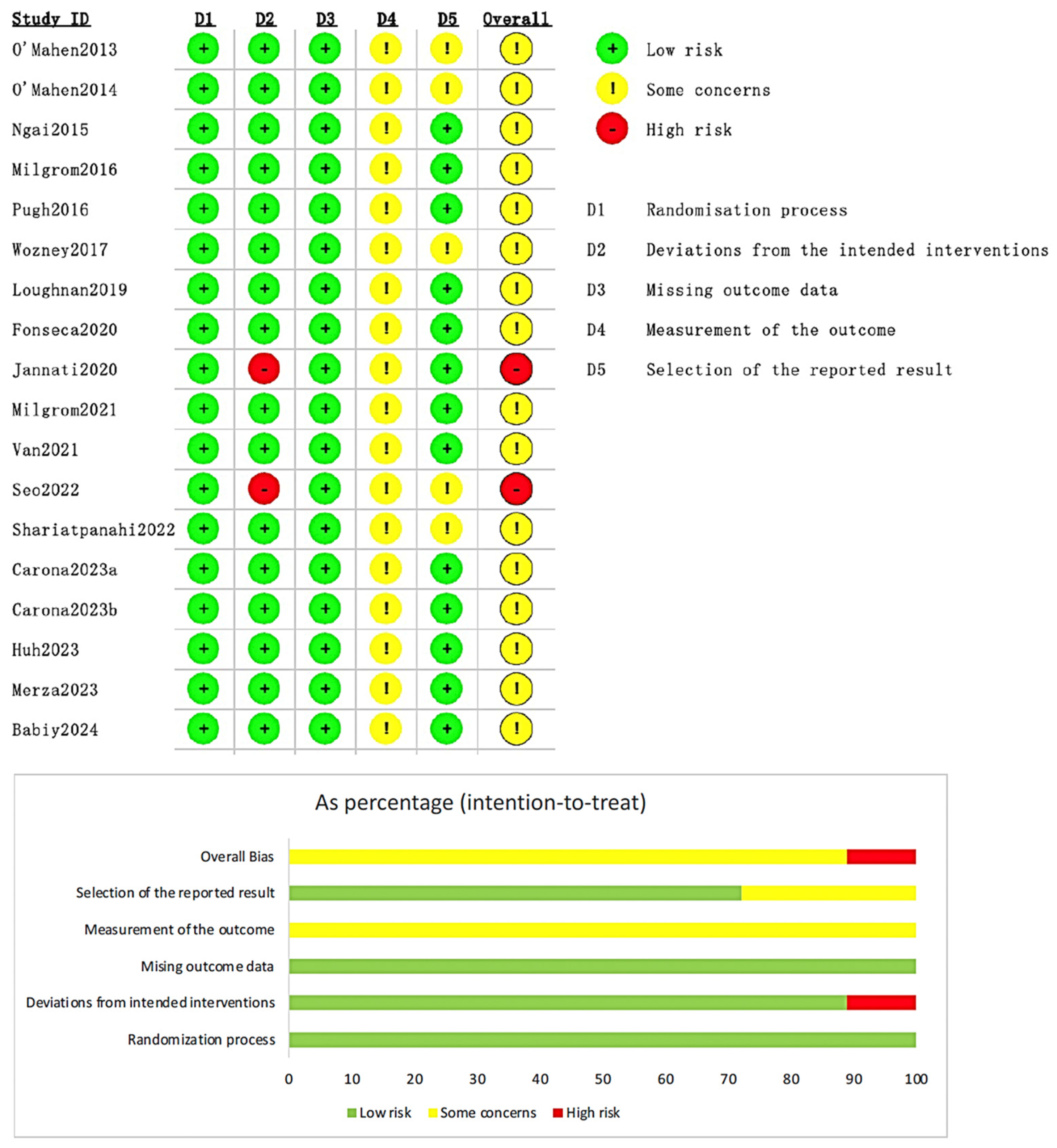


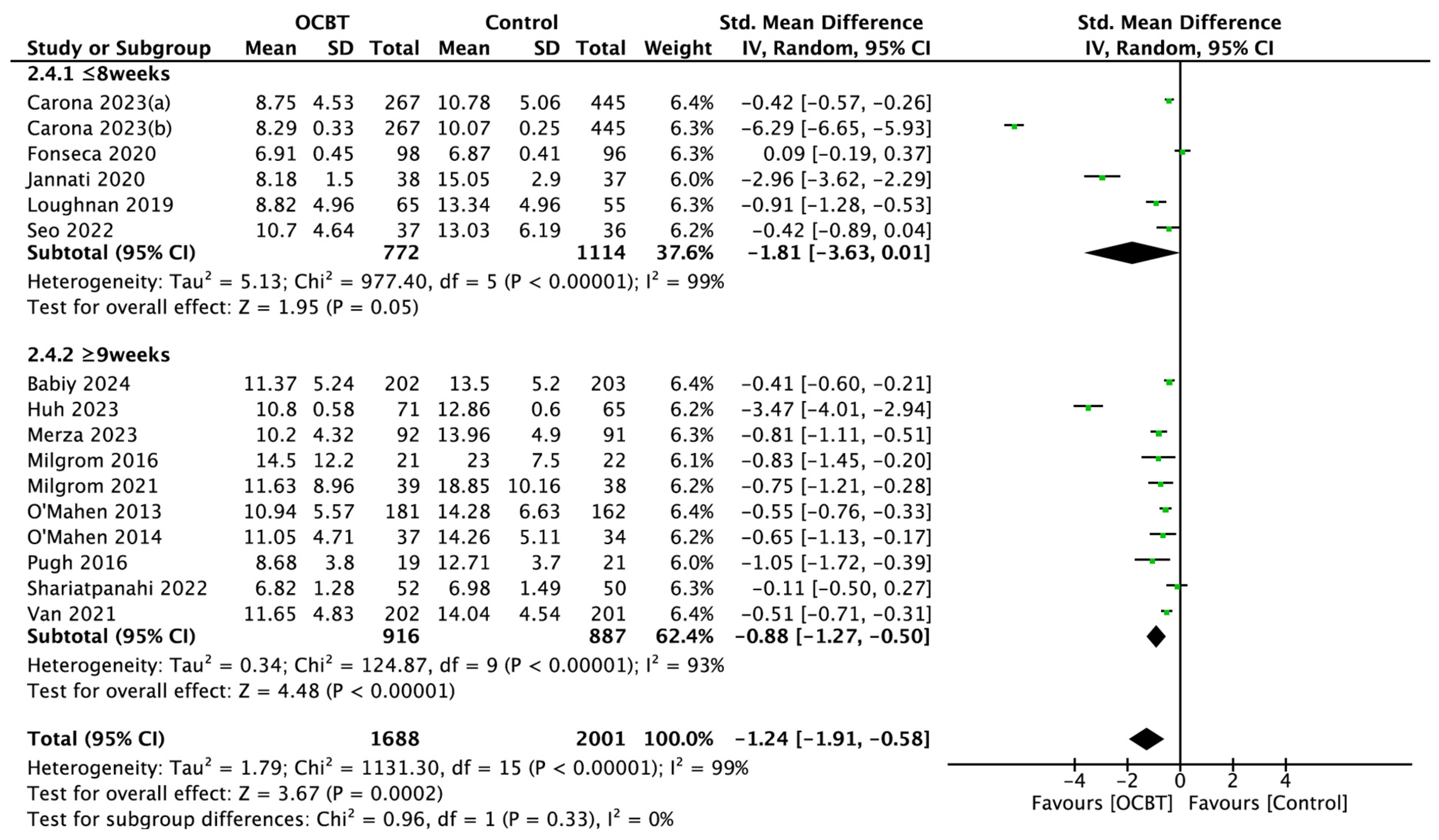
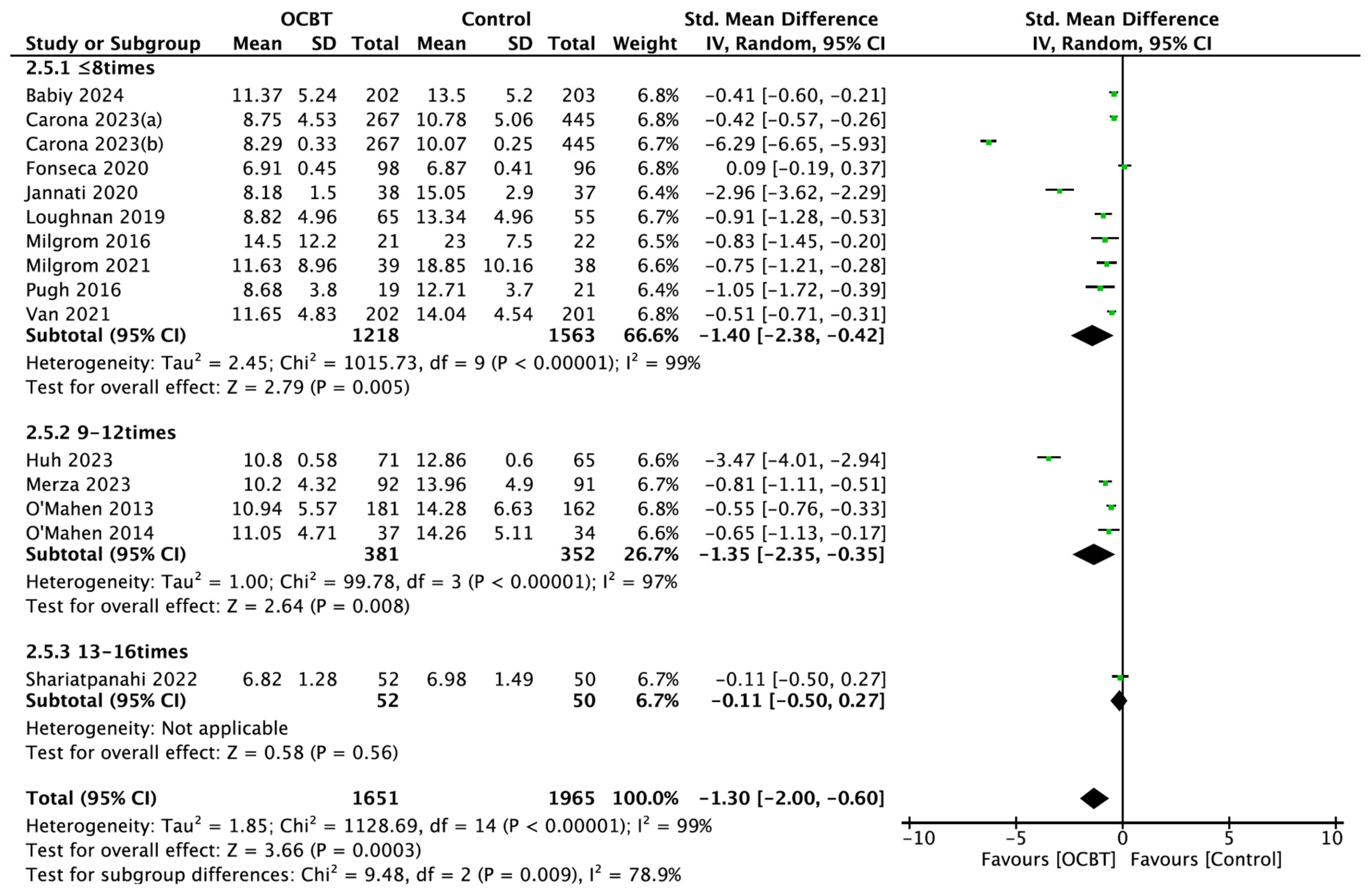
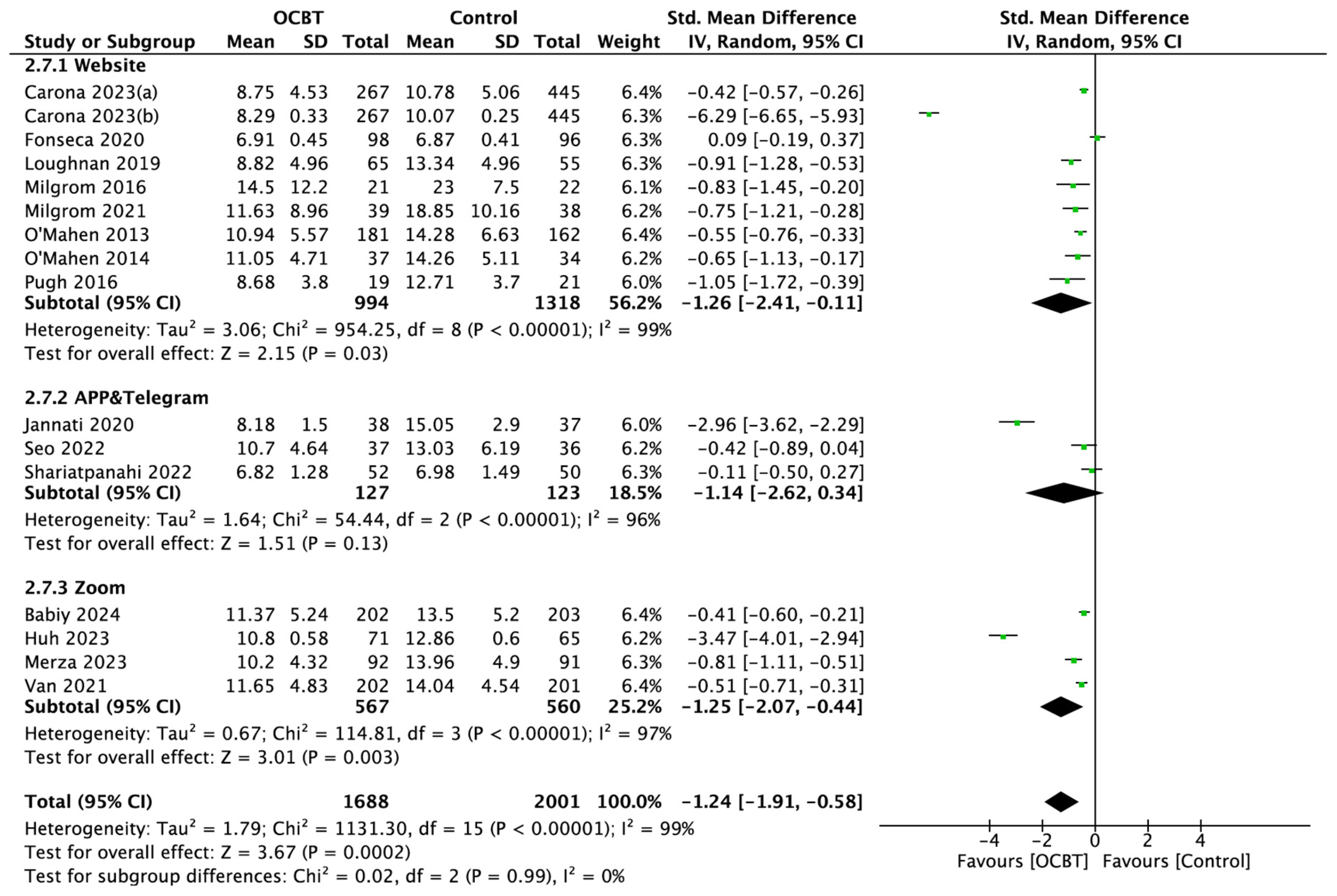
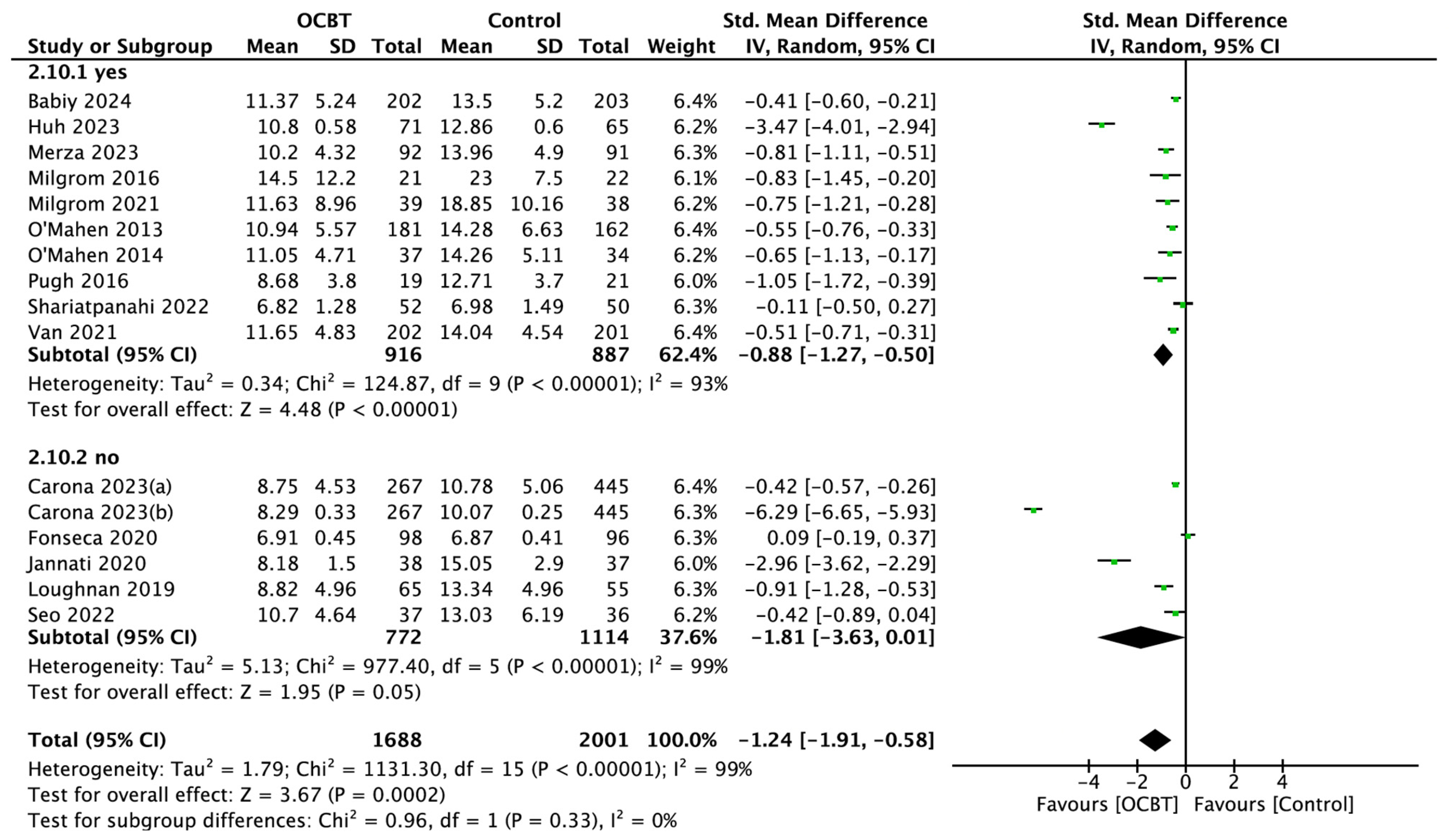
| Author (Year) | Country | Participant | Sample Size (I/C) | Intervention | Comparison | Outcome | ||||||||
|---|---|---|---|---|---|---|---|---|---|---|---|---|---|---|
| Total Duration | Number | Each Duration | Platform | Module Number | Form | Guidance Provided | Nurse Participation | Measurement | Data- Collection Time Point | |||||
| Babiy et al., 2024 [24] | Canada | Postpartum women | 405 (202/203) | 12 weeks | 1 | 6 h | Zoom | 4 | Team | Yes | No | TAU + WLC | EPDS | T0 T1 |
| Carona et al., 2023 [25] | Portugal | Postpartum women | 1053 (542/511) | 8 weeks | 5 | 45 min | Website | 5 | Personal | No | No | TAU | EPDS | T0 T1 |
| Carona et al., 2023 [26] | Portugal | Postpartum women | 1053 (542/511) | 8 weeks | 5 | 45 min | Website | 5 | Personal | No | No | TAU | EPDS | T0 T2 |
| Fonseca et al., 2020 [27] | Portugal | Postpartum women | 194 (98/96) | 8 weeks | 5 | / | Website | 5 | Personal | No | No | WLC | EPDS | T0 T1 |
| Huh et al., 2023 [17] | Canada | Postpartum women | 159 (80/79) | 9 weeks | 9 | 2 h | Zoom | 9 | Team | Yes | Yes | TAU | EPDS | T0 T1 T2 |
| Jannati et al., 2020 [28] | Iran | Postpartum women | 78 (39/39) | 8 weeks | 8 | 45–60 min | APP | 8 | Personal | No | No | TAU | EPDS | T0 T1 |
| Loughnan et al., 2019 [34] | Australia | Postpartum women | 131 (69/62) | 6 weeks | 3 | / | Website | 3 | Personal | No | No | TAU | EPDS | T0 T1 T2 |
| Merza et al., 2023 [29] | Canada | Postpartum women | 183 (92/91) | 9 weeks | 9 | 2 h | Zoom | 9 | Team | Yes | No | TAU + WLC | EPDS | T0 T1 T2 |
| Milgrom et al., 2016 [35] | Australia | Postpartum women | 43 (21/22) | 12 weeks | 6 | / | Website | 6 | Personal | Yes | No | TAU | BDI | T0 T1 |
| Milgrom et al., 2021 [21] | Australia | Postpartum women | 77 (39/38) | 9 weeks | 6 | / | Website | 6 | Personal | Yes | No | TAU | BDI | T0 T1 T2 |
| Ngai et al., 2015 [18] | China | Postpartum women | 397 (197/200) | 5 weeks | 5 | 20–30 min | APP | 5 | Personal | Yes | Yes | TAU | EPDS | T0 T1 T2 |
| O’Mahen et al., 2013 [36] | UK | Postpartum women | 910 (462/448) | 15 weeks | 11 | Up to 40 min | Website | 11 | Personal | Yes | No | TAU | EPDS | T0 T1 |
| O’Mahen et al., 2014 [37] | UK | Postpartum women | 83 (41/42) | 12 weeks | 12 | / | Website | 12 | Personal | Yes | No | TAU | EPDS | T0 T1 T2 |
| Pugh et al., 2016 [38] | Canada | Postpartum women | 50 (25/25) | 10 weeks | 7 | / | Website | 7 | Personal | Yes | No | WLC | EPDS | T0 T1 T2 |
| Seo et al., 2022 [22] | South Korea | Postpartum women | 100 (50/50) | 8 weeks | / | / | APP | / | Personal | / | No | TAU | EPDS | T0 T1 T2 |
| Shariatpanahi et al., 2022 [30] | Iran | Postpartum women | 102 (52/50) | 16 weeks | 16 | / | Telegram | / | Personal | Yes | No | Medicine | EPDS | T0 T1 |
| Van et al., 2021 [31] | Canada | Postpartum women | 403 (202/201) | 12 weeks | 4 | 1 day | Zoom | 4 | Team | Yes | No | TAU | EPDS | T0 T1 |
| Wozney et al., 2017 [39] | Canada | Postpartum women | 62 (32/30) | 12 weeks | 12 | / | Website | 12 | Personal | Yes | No | TAU | BDI | T0 T1 T2 |
Disclaimer/Publisher’s Note: The statements, opinions and data contained in all publications are solely those of the individual author(s) and contributor(s) and not of MDPI and/or the editor(s). MDPI and/or the editor(s) disclaim responsibility for any injury to people or property resulting from any ideas, methods, instructions or products referred to in the content. |
© 2025 by the authors. Licensee MDPI, Basel, Switzerland. This article is an open access article distributed under the terms and conditions of the Creative Commons Attribution (CC BY) license (https://creativecommons.org/licenses/by/4.0/).
Share and Cite
Pan, J.; Luo, W.; Zhang, H.; Wang, Y.; Lu, H.; Wang, C.; Li, C.; Fu, L.; Hu, Y.; Li, Y.; et al. The Effects of Online Cognitive Behavioral Therapy on Postpartum Depression: A Systematic Review and Meta-Analysis. Healthcare 2025, 13, 696. https://doi.org/10.3390/healthcare13070696
Pan J, Luo W, Zhang H, Wang Y, Lu H, Wang C, Li C, Fu L, Hu Y, Li Y, et al. The Effects of Online Cognitive Behavioral Therapy on Postpartum Depression: A Systematic Review and Meta-Analysis. Healthcare. 2025; 13(7):696. https://doi.org/10.3390/healthcare13070696
Chicago/Turabian StylePan, Jingyu, Wenjing Luo, Haijuan Zhang, Yong Wang, Hong Lu, Chongkun Wang, Chunying Li, Li Fu, Yinchu Hu, Yuxuan Li, and et al. 2025. "The Effects of Online Cognitive Behavioral Therapy on Postpartum Depression: A Systematic Review and Meta-Analysis" Healthcare 13, no. 7: 696. https://doi.org/10.3390/healthcare13070696
APA StylePan, J., Luo, W., Zhang, H., Wang, Y., Lu, H., Wang, C., Li, C., Fu, L., Hu, Y., Li, Y., & Shen, M. (2025). The Effects of Online Cognitive Behavioral Therapy on Postpartum Depression: A Systematic Review and Meta-Analysis. Healthcare, 13(7), 696. https://doi.org/10.3390/healthcare13070696







